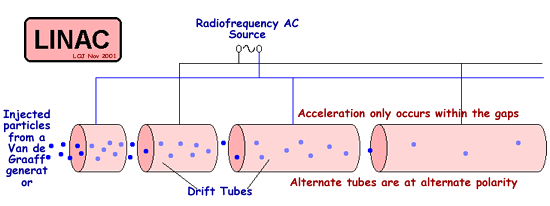|
A linac -
linear accelerator - is a type of particle accelerator in which
charged particles are accelerated in a straight line.
This is done
either by a steady electrical field or by means of radio-frequency
alternating electric fields (typically in the range 12 - 24 MHz, in the middle of the shortwave band). Using a steady electric field would
require a massive voltage over a large distance. This would have
implications for insulation and safety. The more common aproach
is to use radio-frequency alternating electric fields that are
applied over short distances to 'kick' the particles into a higher
energy.

The charged particles are accelerated by an electric field that is applied between the drift tubes (across the gap between them). The particles
travel in 'drift tubes' between 'kicks' by the electric field. As the particles
leave a tube section there must be an accelerating field across
the gap so the tube it is in must be of the same potential as the
particle's charge (repelling it away from where it has come from)
and the one it is about to enter be of the opposite potential
(attracting it towards the next tube).When it enters the drift tube it must experience NO electric field so that it 'drifts' on at the same velocity until the half of the cycle when it can be accelerated again.The drift tubes are made of conducting
material and therefore form 'Faraday cages'.
The Faraday Cage
Effect (named after its discoverer) means that the electric charge
on a conductor sits on the outer surface of it. Therefore, no
electrostatic field is present within the conductor. This is done
so that the alternating potential does not affect the particles
when it is in opposition to the direction they are travelling. The
passage of the particle between drift tubes is synchronized with
the phase of the accelerating field - the particle is only subjected
to the field when it is in the part of the cycle that accelerates
it (not the other half which would decelerate it!).
The tube sections
need to get larger as the particles travel faster as they have
to be inside the tube for the full half cycle
The equation
that allows you to work out the acceleration is:
F
= qE
where
F is
the force vector,
q is
the charge and
E is
the electric field intensity vector.
Once you know the force you can woork out the
acceleration by using;
F = ma
where
F is
the force vector,
m is
the mass and
a is
the particle's acceleration vector.
The SLAC Linear
Accelerator (linac) is a two-mile long accelerator, consisting
of a cylindrical, disc-loaded, copper waveguide placed on concrete
girders in a tunnel about 25 feet underground.

Experimental
research began at SLAC (Stanford Linear Accelerator Center) in 1966
with the completion of the two-mile-long linear electron accelerator
or linac, a machine capable of producing an electron beam with an
energy up to 20 GeV (giga-electron volts) or 20 billion electron
volts. Initial experiments directed these electrons onto stationary
targets to study the structure of matter. The maximum energy of
the linac was increased over the years to 50 GeV. The two-mile accelerator
continues to generate high-intensity beams of electrons with the
highest energy available in the world.
Linac
use in medical facilities
A linear accelerator
(LINAC) is the device most commonly used for external beam radiation
treatments for patients with cancer. The linear accelerator can
also be used in stereotactic radiosurgery similar to that achieved
using the gamma knife on targets within the brain. The linear accelerator
can also be used to treat areas outside of the brain. The very high
speed electrons from it produce a uniform dose of high-energy x-rays
when fired at a metal target. These can then be directed to the
region of the patient's tumorr. These x-rays can destroy the cancer
cells while sparing the surrounding normal tissue.
How does
it work?
 The
medical use of the linear accelerator uses microwave technology
(similar to that used for radar) to accelerate electrons in a part
of the accelerator called the "wave guide", then allows
these electrons to collide with a heavy metal target. As a result
of the collisions, high-energy x-rays are scattered from the target.
A portion of these x-rays is collected and then shaped to form a
beam that matches the patient's tumour. The beam comes out of a
part of the accelerator called a gantry, which rotates around the
patient. The patient lies on a moveable treatment couch and lasers
are used to make sure the patient is in the proper position. Radiation
can be delivered to the tumor from any angle by rotating the gantry
and moving the treatment couch. The
medical use of the linear accelerator uses microwave technology
(similar to that used for radar) to accelerate electrons in a part
of the accelerator called the "wave guide", then allows
these electrons to collide with a heavy metal target. As a result
of the collisions, high-energy x-rays are scattered from the target.
A portion of these x-rays is collected and then shaped to form a
beam that matches the patient's tumour. The beam comes out of a
part of the accelerator called a gantry, which rotates around the
patient. The patient lies on a moveable treatment couch and lasers
are used to make sure the patient is in the proper position. Radiation
can be delivered to the tumor from any angle by rotating the gantry
and moving the treatment couch.
Who operates
this equipment?
The patient's
radiation oncologist prescribes the appropriate treatment volume
and dosage. The medical radiation physicist and the dosimetrist
determine how to deliver the prescribed dose and calculate the amount
of time it will take the accelerator to deliver that dose. Radiation
therapists operate the linear accelerator and give patients their
daily radiation treatments.
How is safety
ensured?
 Patient
safety is very important. During treatment the radiation therapist
continuously watches the patient through a closed-circuit television
monitor. There is also a microphone in the treatment room so that
the patient can speak to the therapist if needed. Port films (x-rays
taken with the treatment beam) are checked regularly to make sure
that the beam position doesn't vary from the original plan. Patient
safety is very important. During treatment the radiation therapist
continuously watches the patient through a closed-circuit television
monitor. There is also a microphone in the treatment room so that
the patient can speak to the therapist if needed. Port films (x-rays
taken with the treatment beam) are checked regularly to make sure
that the beam position doesn't vary from the original plan.
The linear accelerator
sits in a room with lead and concrete walls so that the high-energy
x-rays are absorbed and do not increase the risk of cancer for Staff.
The radiation therapist must turn on the accelerator from outside
the treatment room. Because the accelerator only gives off radiation
when it is actually turned on, the risk of accidental exposure is
extremely low. Indeed, pregnant women are allowed to operate linear
accelerators because the safety levels are so high.
Modern radiation
machines have internal checking systems to provide further safety
so that the machine will not turn on until all the treatment requirements
prescribed by your physician are perfect. When all the checks match
and are perfect, the machine will turn on to give your treatment.
Quality control
of the linear accelerator is also very important. There are several
systems built into the accelerator so that it won't deliver a higher
dose than the radiation oncologist prescribed. Each morning before
any patients are treated, the radiation therapist uses a piece of
equipment called a "tracker" to make sure that the radiation
intensity is uniform across the beam. In addition, the radiation
physicist makes more detailed weekly and monthly checks of the accelerator
beam.
LOJ
November 2001- amended December 2006 to include medical applications-
information taken from www.radiologyinfo.org
|











